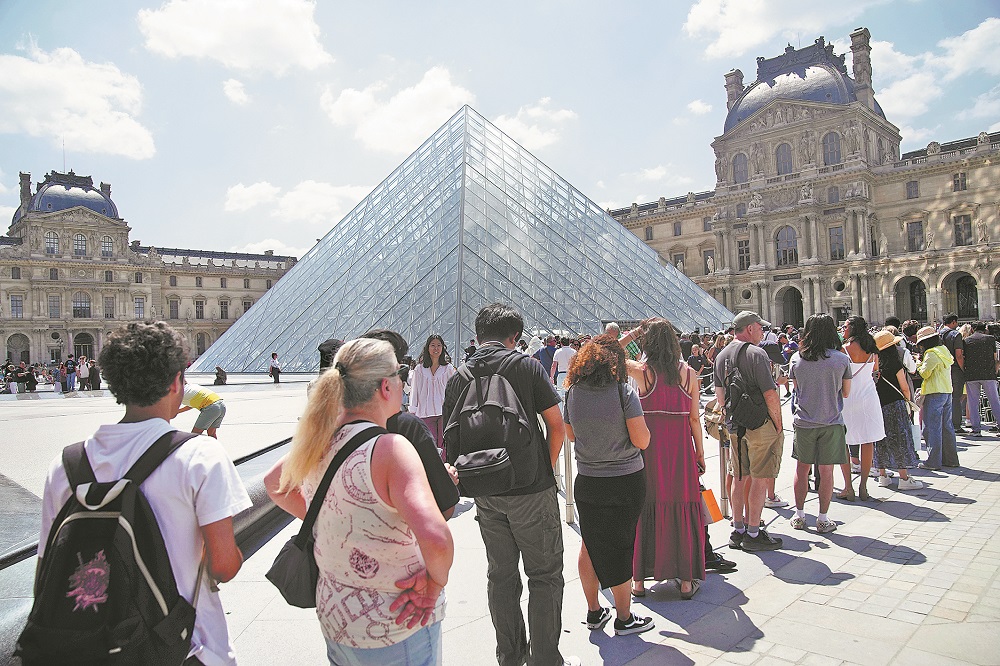Louvre closes as staffers strike over mass tourism


PARIS — The Louvre, the world's most-visited museum and a global symbol of art, beauty and endurance, has withstood war, terror and pandemic — but on Monday, it was brought to a halt by its own striking staff, who say the institution is crumbling under the weight of mass tourism.
Thousands of stranded and confused visitors, tickets in hand, were corralled into unmoving lines by I.M. Pei's glass pyramid.
"It's the Mona Lisa moan out here," said Kevin Ward, 62, from Milwaukee, the United States. "Thousands of people waiting, no communication, no explanation. I guess even she needs a day off."
The Louvre has become a symbol of tourism pushed to its limits. As hot spots from Venice to the Acropolis race to curb crowds, the world's most iconic museum, visited by millions, is hitting a breaking point of its own.
Just a day earlier, coordinated anti-tourism protests swept across southern Europe. Thousands rallied in Mallorca, Venice, Lisbon and beyond, denouncing an economic model they say displaces locals and erodes city life.
The Louvre's spontaneous strike erupted during a routine internal meeting, as gallery attendants, ticket agents and security personnel refused to take up their posts in protest over unmanageable crowds, chronic understaffing and what one union called "untenable" working conditions.
It's rare for the Louvre to close its doors. It has happened during war, during the pandemic, and in a handful of strikes. But seldom has it happened so suddenly, without warning, and in full view of the crowds.
What's more, the disruption comes just months after President Emmanuel Macron unveiled a sweeping decade-long plan to rescue the Louvre from precisely the problems now boiling over — water leaks, dangerous temperature swings, outdated infrastructure, and foot traffic far beyond what the museum can handle.
But for workers on the ground, that promised future feels distant.
"We can't wait six years for help," said Sarah Sefian, a front-of-house gallery attendant and visitor services agent. "Our teams are under pressure now. It's not just about the art — it's about the people protecting it."
At the center of it all is the Mona Lisa — a 16th-century portrait that draws modern-day crowds more akin to a celebrity meet-and-greet than an art experience.
Roughly 20,000 people a day squeeze into the Salle des Etats, the museum's largest room, just to snap a selfie with Leonardo da Vinci's enigmatic woman behind protective glass. The scene is often noisy, jostling, and so dense that many barely glance at the masterpieces flanking her — works by Titian and Veronese that go largely ignored.
Own room
Macron's renovation blueprint, dubbed the "Louvre New Renaissance", promises a remedy. The Mona Lisa will finally get her own dedicated room, accessible through a timed-entry ticket. A new entrance near the Seine River is also planned by 2031 to relieve pressure from the overwhelmed pyramid hub.
But Louvre workers said the 700 million to 800 million euros ($730 million to $834 million) renovation plan masks a deeper crisis. While Macron is investing in new entrances and exhibition space, the Louvre's annual operating subsidies from the French state have shrunk by more than 20 percent over the past decade — even as visitor numbers soared.
The Louvre welcomed 8.7 million visitors last year — more than double what its infrastructure was designed to accommodate. Even with a daily cap of 30,000, staff say the experience has become a daily test of endurance, with too few rest areas, limited bathrooms, and summer heat magnified by the pyramid's greenhouse effect.
AGENCIES VIA XINHUA

































